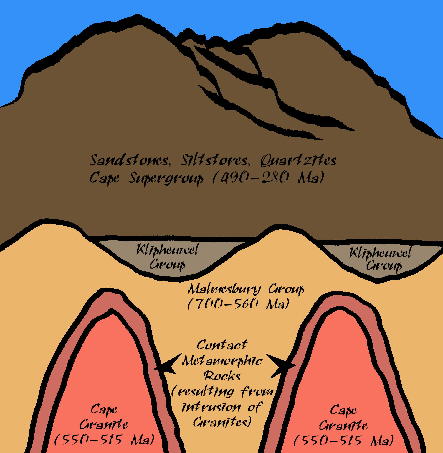

The Geological History of the Helderberg
With grateful thanks to Reyno Scheepers
Once upon a land in a faraway time ......
.... no, this story is best started with a picture. The diagram below shows the the heart and sole (foundation) of the Helderberg.

Looking Towards the Hottentots Holland Mountains
from Hare-Yama Ryu
Malmesbury Group
The oldest rocks in the basin are the Malmesbury Group, aged 700 to 560 Ma (million years). This group consists of sedimentary and volcanic rocks that were metamorphosed by extreme temperature and pressure during intrusion of the Cape Granites.
The Cape Granites
The Cape Granites intruded into the Malmesbury Group from 550 to 515 Ma. Granites were molten rock at 780 °C which intruded to a depth of 8 to 10 km at 550 Ma. Later intrusions (520 Ma) were shallower (1 to 2 km) and eventually some volcanic activity followed with eruptions bringing lava to the Earth’s surface.
Klipheuwel Group
Through geological processes and erosion, the surface changed and basins started to form at 510 Ma. Klipheuwel Group sediments were deposited in these basins.
Cape Supergroup
As the basin grew larger, a shallow sea environment developed. The base of the Cape Supergroup was deposited at about 490 to 470 Ma. Sedimentation in this sea environment continued up to about 280 Ma when the last sediments formed. These last sediments are preserved as the top of the Hottentots Holland Mountains.
The Hottentots Holland Mountains
Since the last sediments formed, weathering has sculpted the Cape Supergroup layer to form the magnificent Hottentots Holland mountain range that now graces our northern and eastern skyline.